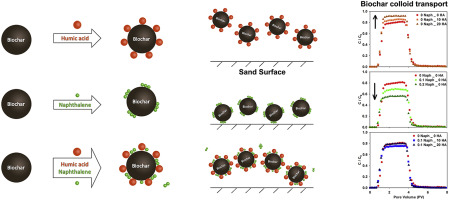当前位置:
X-MOL 学术
›
Chemosphere
›
论文详情
Our official English website, www.x-mol.net, welcomes your
feedback! (Note: you will need to create a separate account there.)
Antagonistic effect of humic acid and naphthalene on biochar colloid transport in saturated porous media
Chemosphere ( IF 8.1 ) Pub Date : 2017-09-15 , DOI: 10.1016/j.chemosphere.2017.09.060 Wen Yang , Yang Wang , Jianying Shang , Kesi Liu , Prabhakar Sharma , Juan Liu , Baoguo Li
Chemosphere ( IF 8.1 ) Pub Date : 2017-09-15 , DOI: 10.1016/j.chemosphere.2017.09.060 Wen Yang , Yang Wang , Jianying Shang , Kesi Liu , Prabhakar Sharma , Juan Liu , Baoguo Li

|
Biochar is a carbon-enriched material derived from organic material pyrolysis under no/limited oxygen, which is widely used for soil amendment, carbon sequestration, and contaminated soil remediation. This study aims to explore the interplay effect of humic acid (HA) and naphthalene on transport of biochar colloid (BC) in saturated porous media. A series of column experiments were conducted to study BC mobility at different concentrations of HA (0, 10, and 20 mg L−1) and naphthalene (0, 0.1, and 0.2 mg L−1). The results showed that increasing HA concentration promoted BCs mobility in porous media by increasing the electrostatic and steric interaction between BCs and collectors. However, the presence of naphthalene reduced the mobility of BCs with naphthalene increasing from 0 to 0.2 mg L−1, because the nonpolar naphthalene adsorbed onto the biochar surface and shielded the negative charge of BCs. The maximum breakthrough C/C0 of BCs was increased from 0.70 to 0.80 with increasing HA concentration from 0 to 20 mg L−1 in the presence of 0.1 mg L−1 naphthalene. This meant that HA still played the role to increase the electrostatic repulsion between BCs with HA and collectors when naphthalene was adsorbed on BCs. BCs breakthrough curves were well described by the two-site kinetic retention model including one reversible retention site and another irreversible retention site. The antagonistic effects of naphthalene and HA on BC transport suggested that the mobility of colloidal biochar particles in naphthalene-polluted soil was dependent on the coupled effects of naphthalene and natural organic matter.
中文翻译:

腐殖酸和萘对饱和多孔介质中生物炭胶体迁移的拮抗作用
Biochar是一种富含碳的物质,它是在无氧/无氧条件下,通过有机材料的热解而得到的,广泛用于土壤改良,固碳和污染土壤的修复。这项研究旨在探讨腐殖酸(HA)和萘对饱和多孔介质中生物炭胶体(BC)转运的相互作用。进行了一系列柱实验,以研究不同浓度的HA(0、10和20 mg L -1)和萘(0、0.1和0.2 mg L -1)下的BC迁移率)。结果表明,增加HA浓度可通过增加BCs和收集器之间的静电和空间相互作用来促进BCs在多孔介质中的迁移。然而,萘的存在降低了BCs的迁移率,其中萘从0增加到0.2 mg L -1,这是因为非极性萘吸附到生物炭表面并屏蔽了BCs的负电荷。在存在0.1 mg L -1的情况下,随着HA浓度从0增加至20 mg L -1,BC的最大穿透C / C 0从0.70增加至0.80萘。这意味着当萘吸附在BCs上时,HA仍然起着增加BCs与HA和收集器之间静电排斥的作用。两点动力学保留模型很好地描述了BCs的突破曲线,该模型包括一个可逆保留点和另一个不可逆保留点。萘和HA对BC转运的拮抗作用表明,胶体生物炭颗粒在萘污染的土壤中的迁移率取决于萘与天然有机物的耦合作用。
更新日期:2017-09-15
中文翻译:

腐殖酸和萘对饱和多孔介质中生物炭胶体迁移的拮抗作用
Biochar是一种富含碳的物质,它是在无氧/无氧条件下,通过有机材料的热解而得到的,广泛用于土壤改良,固碳和污染土壤的修复。这项研究旨在探讨腐殖酸(HA)和萘对饱和多孔介质中生物炭胶体(BC)转运的相互作用。进行了一系列柱实验,以研究不同浓度的HA(0、10和20 mg L -1)和萘(0、0.1和0.2 mg L -1)下的BC迁移率)。结果表明,增加HA浓度可通过增加BCs和收集器之间的静电和空间相互作用来促进BCs在多孔介质中的迁移。然而,萘的存在降低了BCs的迁移率,其中萘从0增加到0.2 mg L -1,这是因为非极性萘吸附到生物炭表面并屏蔽了BCs的负电荷。在存在0.1 mg L -1的情况下,随着HA浓度从0增加至20 mg L -1,BC的最大穿透C / C 0从0.70增加至0.80萘。这意味着当萘吸附在BCs上时,HA仍然起着增加BCs与HA和收集器之间静电排斥的作用。两点动力学保留模型很好地描述了BCs的突破曲线,该模型包括一个可逆保留点和另一个不可逆保留点。萘和HA对BC转运的拮抗作用表明,胶体生物炭颗粒在萘污染的土壤中的迁移率取决于萘与天然有机物的耦合作用。











































 京公网安备 11010802027423号
京公网安备 11010802027423号